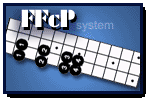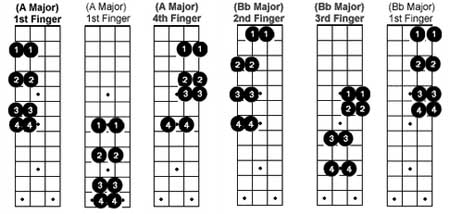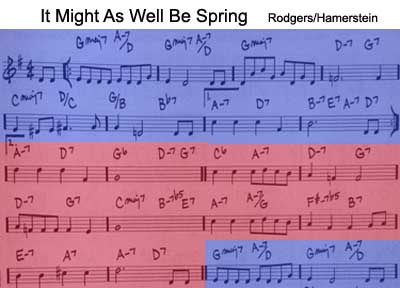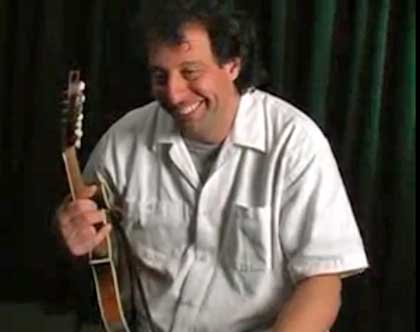« March 2014 |
Main
| May 2014 »
 April 24, 2014 | Learn To Play In Every Key (Part Two). Baron Collins-Hill
April 24, 2014 | Learn To Play In Every Key (Part Two). Baron Collins-Hill

JazzMando friend and FFcP disciple Baron Collins-Hill has posted a follow-up to last week's lesson on scale movability through his YouTube video channel, MandoLessons.
Last week's lesson: Learn To Play In Every Key (Part Two). Baron Collins-Hill
The series' second entry takes you farther up the fretboard. Baron demonstrates how simple it is to move into playing in the fretboard stratosphere by starting the same scale on a different finger. Also he gives helpful tips on how the FFcP allows you to stack patterns based on multiple FFcP fingerings with minimal shifting.
Video Link: Learn To Play In Every Key (Part Two)

Further:
Moving on up. And around.
FFcP Index
"The notes seem to come from out of nowhere."
Stuff you can get for free at JazzMando
Numbers.
Posted by Ted at 11:20 AM
 April 17, 2014 | Learn To Play In Every Key (Part One). Baron Collins-Hill
April 17, 2014 | Learn To Play In Every Key (Part One). Baron Collins-Hill
 JazzMando friend and FFcP disciple Baron Collins-Hill is posting some marvelous introductory videos to help you grasp basic playing concepts. His latest is a series that outlines visually and in real time, the approach and the benefits of closed position studies, beginning with the 1st FFcP pattern based on the scale starting on the 1st finger. If you haven't started down this path or want help explaining the concept to another beginner, this is a great resource. JazzMando friend and FFcP disciple Baron Collins-Hill is posting some marvelous introductory videos to help you grasp basic playing concepts. His latest is a series that outlines visually and in real time, the approach and the benefits of closed position studies, beginning with the 1st FFcP pattern based on the scale starting on the 1st finger. If you haven't started down this path or want help explaining the concept to another beginner, this is a great resource.
The series' first entry is an introduction into the basics and how to eventually move and apply it up the fretboard. Baron demonstrates how simple it is to move into playing in the more folk foreign flat keys. Also he gives helpful tips on how the FFcP forces optimal hand placement and finger spread.
Video Link: Learn To Play In Every Key (Part One)
Review: Principles of FFcP
- In this system, there are only four ways to play a major scale: starting with the first finger, the second, the third and the fourth. That's it!
- All 12 keys can be covered in only four different positions, simply by transposing up or down the fretboard and across strings.
- 4th Finger (Pinky) strength and coordination become part of daily development exercises.
- Key Chord Tone relationships in improvising become tactile, visible, and intuitively real.
- Position shifts to a second octave are easily bridged merely by starting the next octave with a different FFcP pattern.
- Changes in tonal "micro-centers" by half steps easily transist either by moving the pattern by one fret, or using the next FFcP.
Further:
"The notes seem to come from out of nowhere."
Stuff you can get for free at JazzMando
Moving on up. And around.
Numbers.
FFcP Index
Posted by Ted at 9:11 AM
 April 10, 2014 | Keying into FFcP
April 10, 2014 | Keying into FFcP
So you've been practicing your FFcP Scales, mastering the 3rd, 4th, and arpeggios, major and minor, and you feel pretty good about them. Now you're in a funk because despite the pride you have in this accomplishment, you wonder what's next? What do I do with these skills?
From a purely physical, finesse and flexibility point of view, the FFcP drills could almost stand on their own. Your 3rd and 4th fingers are more independent, you've lost the initial fear of the upper fretboard, but now you wonder, how do I use these to make music?
We advocate leaving some of these in your daily practice routine, but we want to suggest incorporating them directly into the literature you're playing, be it jazz standards, fiddle tunes, or improvising church or pop/rock music. You might already be doing this, diving practicing into FFcP and songs, but keeping them as separate entities. We'd like to encourage you to think key regions (tonal centers) and scale fodder.
Let's say you're working on the great Rogers & Hammerstein song "It Might As Well Be Spring." It's a fairly simple tune harmonically, stripped of a few stray 'ii V7 I' harmonic detours it's just two keys. In G Major, it's G and C Major.

We've colored the section blue for G and red for C. So what you want to do is start your practice drilling the FFcP keys of G and C Major, and get them into your fingers before playing the song.
 
Next step is to take what you've internalized as G and C pathways and start on your improvisation. Don't worry about the color tones of the secondary dominants for now, just concentrate on the two keys.
When this is comfortable, try some different inversions of the FFcP, in this case, we move from the FFcP 3 to the FFcP 2, up two frets. Again practice them before returning to the song.
 
This seems simplistic, but it's an approach that can make your practice sessions more interesting, focus on specify keys, and get comfortable moving your "base" up the fretboard and back.
Try the same thing with a song like "These Are a Few of My Favorite Things." Take some time to isolate the keys, yourself first. You'll need three keys, E Minor, G Major, and E Major. Drilling through the FFcP scales in these keys will go miles in not only getting comfortable with your own pathways, but the 'ii vi7 ii7 I' part of your FFcP drill will help you to communicate important chord tones.
Further:
Four Finger Closed Position FFcP
FFcP vs Closed Fingerings Scales
Raking it in. Autumn Leaves Pt. 2
Sneaking Theory
Approaching Improvisation
Posted by Ted at 3:01 PM
 April 3, 2014 | Mike Marshall on switching instruments
April 3, 2014 | Mike Marshall on switching instruments

In this D'Addario video, world renown multi-instrumentalist/educator Mike Marshall gives a visual primer on the difference in playing and how to approach mandolin, mandocello, guitar, violin, banjo, and dobro.
Video Link: Mike Marshall on switching instruments
Further
Guitar to mandolin
Mike Marshall ArtistWorks School of Mandolin
Plays Well With Others...
A common mistake. Clacky, clacky...
Mandolin Tuning with Mike Marshall
Posted by Ted at 2:25 PM

Disclaimer: In the 'Information Age' of the 21st Century,
any fool with a computer, a modem, and an idea can
become a self-professed 'expert." This site does not
come equipped with 'discernment.'
|



